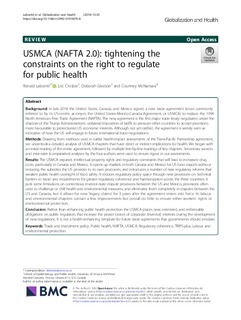| dc.contributor.author | Labonté, Ronald | |
| dc.contributor.author | Crosbie, Eric | |
| dc.contributor.author | Gleeson, Deborah | |
| dc.contributor.author | McNamara, Courtney L. | |
| dc.date.accessioned | 2019-10-07T10:25:11Z | |
| dc.date.available | 2019-10-07T10:25:11Z | |
| dc.date.created | 2019-05-15T13:26:26Z | |
| dc.date.issued | 2019 | |
| dc.identifier.citation | Globalization and Health. 2019, 15:35 1-15. | nb_NO |
| dc.identifier.issn | 1744-8603 | |
| dc.identifier.uri | http://hdl.handle.net/11250/2620598 | |
| dc.description.abstract | Background
In late 2018 the United States, Canada, and Mexico signed a new trade agreement (most commonly referred to by its US-centric acronym, the United States-Mexico-Canada Agreement, or USMCA) to replace the 1994 North American Free Trade Agreement (NAFTA). The new agreement is the first major trade treaty negotiated under the shadow of the Trump Administration’s unilateral imposition of tariffs to pressure other countries to accept provisions more favourable to protectionist US economic interests. Although not yet ratified, the agreement is widely seen as indicative of how the US will engage in future international trade negotiations.
Methods
Drawing from methods used in earlier health impact assessments of the Trans-Pacific Partnership agreement, we undertook a detailed analysis of USMCA chapters that have direct or indirect implications for health. We began with an initial reading of the entire agreement, followed by multiple line-by-line readings of key chapters. Secondary sources and inter-rater (comparative) analyses by the four authors were used to ensure rigour in our assessments.
Results
The USMCA expands intellectual property rights and regulatory constraints that will lead to increased drug costs, particularly in Canada and Mexico. It opens up markets in both Canada and Mexico for US food exports without reducing the subsidies the US provides to its own producers, and introduces a number of new regulatory reforms that weaken public health oversight of food safety. It reduces regulatory policy space through new provisions on ‘technical barriers to trade’ and requirements for greater regulatory coherence and harmonization across the three countries. It puts some limitations on contentious investor-state dispute provisions between the US and Mexico, provisions often used to challenge or chill health and environmental measures, and eliminates them completely in disputes between the US and Canada; but it allows for new ‘legacy claims’ for 3 years after the agreement enters into force. Its labour and environmental chapters contain a few improvements but overall do little to ensure either workers’ rights or environmental protection.
Conclusion
Rather than enhancing public health protection the USMCA places new, extended, and enforceable obligations on public regulators that increase the power (voice) of corporate (investor) interests during the development of new regulations. It is not a health-enhancing template for future trade agreements that governments should emulate. | nb_NO |
| dc.language.iso | eng | nb_NO |
| dc.publisher | BMC (part of Springer Nature) | nb_NO |
| dc.rights | Navngivelse 4.0 Internasjonal | * |
| dc.rights.uri | http://creativecommons.org/licenses/by/4.0/deed.no | * |
| dc.title | USMCA (NAFTA 2.0): tightening the constraints on the right to regulate for public health | nb_NO |
| dc.type | Journal article | nb_NO |
| dc.type | Peer reviewed | nb_NO |
| dc.description.version | publishedVersion | nb_NO |
| dc.source.pagenumber | 1-15 | nb_NO |
| dc.source.volume | 15:35 | nb_NO |
| dc.source.journal | Globalization and Health | nb_NO |
| dc.identifier.doi | 10.1186/s12992-019-0476-8 | |
| dc.identifier.cristin | 1698061 | |
| dc.description.localcode | © The Author(s). 2019 Open Access This article is distributed under the terms of the Creative Commons Attribution 4.0 International License (http://creativecommons.org/licenses/by/4.0/) | nb_NO |
| cristin.unitcode | 194,67,25,0 | |
| cristin.unitname | Institutt for sosiologi og statsvitenskap | |
| cristin.ispublished | true | |
| cristin.fulltext | original | |
| cristin.qualitycode | 1 | |

